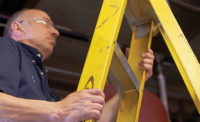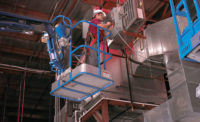Portable ladder falls can be severe but preventable

Workplace falls continue to be a serious safety concern for employers. Although there are many factors that contribute to workplace falls, most injuries are the result of falls to a lower level. In fact, the National Institute for Occupational Safety and Health (NIOSH) reports that falls remain a leading cause of unintentional injury mortality nationwide.
Of those fatalities, NIOSH says that in the last decade 43 percent have involved a ladder. Injuries from these falls can be severe, but fortunately are preventable. Portable ladder safety begins with familiarity and compliance with the provisions of safety regulations and best practice guidance to avoid common missteps.
Types
In general industry, OSHA regulates portable ladders (step, straight, combination and extension) under 1910.25, “Portable wood ladders,” and 1910.26, “Portable metal ladders.” These standards are fairly detailed and provide information on construction, use and maintenance requirements. OSHA does not specifically address fiberglass ladders in either of these standards.
However, under a proposed rule change, “ladder” would be broadly defined to include fiberglass ladders. Also, the requirements for ladders under the proposal apply to all types of portable ladders.
Until the proposal is finalized, a fiberglass ladder should be used, stored, inspected and maintained in accordance with the manufacturer’s recommended conditions of use and/or care instructions, as well as the general requirements of the portable wood and metal ladder standards.
Use
OSHA addresses how a portable ladder must be used in both general industry standards. The Agency also provides ladder safety tips in various guidance documents that include instructions on safe ladder use. Specifically, OSHA requires and recommends the following:
♣ Position the ladder on a stable, level surface.
♣ Place the base of the ladder a quarter of the working length of the ladder from the wall or other vertical surface.
♣ Position the ladder so the side rails extend at least 3 feet above the landing of the roof, mezzanine, etc.
♣ Secure the ladder to prevent displacement or erect a barricade to keep traffic away from the ladder.
♣ Make sure that the weight on the ladder will not cause it to slip off its support.
♣ Do not exceed the maximum load rating of the ladder.
There is no “three points of contact” requirement. The Agency does, however, suggest maintaining three points of contact (two hands and a foot, or two feet and a hand) in guidance, and also elaborates on this issue in the proposed Walking Working Surfaces Standard. If finalized, OSHA would require that employees:
♣ Face the ladder;
♣ Use at least one hand to grasp the ladder when moving up and down the ladder; and
♣ Not carry any object or load that could cause them to lose balance and fall.
Fall protection
OSHA does not require fall protection when using portable ladders, but the Agency addresses fall protection when using ladders in several Letters of Interpretation (LOI). As stated in a Jan. 13, 2000, LOI, if the user is at risk of falling from a portable ladder, then OSHA encourages employers to provide additional fall protection. There are a number of factors to consider in these situations, including:
♣ The height of the ladder;
♣ The type of work being performed;
♣ Conditions of the work environment; and
♣The limitations of the fall arrest system used.
♣ Employees should be properly trained to use a ladder as a means of fall prevention.
Labeling
OSHA also does not require portable ladders to be marked or stickered with specific information. If a manufacturer’s sticker or markings display important safety information (e.g., weight limits), then a faded, worn and/or missing sticker could create a hazard if a user is unaware of the recommended conditions of use and/or care instructions. As such, employers should contact the manufacturer of the ladder for new labels. Be aware that most manufacturers typically will not ship out new labels without first inspecting the ladder.
Storage
OSHA does not prescribe specific storage or securement requirements for ladders. However, OSHA publication, “Stairways and Ladders: A Guide to OSHA Rules,” says that all ladders should be secured in passageways, doorways or driveways, and other areas where they can be accidentally displaced by workplace activities or traffic. This is not a requirement, but rather a recommendation. No further guidance beyond this is provided; therefore, employers must determine the most effective and safe means of ladder storage in the workplace so as not to create a hazard.
Inspection
OSHA requires under 1910.25(d)(1)(x) that portable wood ladders be inspected frequently. Likewise, a portable metal ladder must be inspected immediately if it is involved in any of the situations outlined under 1910.26(c)(2)(vi). Stepladders would fall into either classification depending on their construction.
These requirements do not specify an exact interval for inspection (other than immediate); therefore, employers must determine what inspection frequency is appropriate given the circumstances of their work processes, procedures and environment.
Documentation is not required for ladder inspections, but it would be considered a best practice.
Repairs
Damaged ladders must be taken out of service for repair or destruction and tagged or marked as “Dangerous, Do Not Use” or similar wording. Repairs can be done by either an employer’s designated personnel or the manufacturer. Improvised repairs (e.g., tape) are not allowed.
Modifications
While OSHA doesn’t strictly prohibit the practice of modifying portable ladders, doing so in any way can impact load limits, stability, structural integrity, etc. This could make the ladder unsafe and out of compliance with the design and construction requirements in the prescribed American National Standards Institute standard. As such, ladder modification is not recommended as a best practice.
Conclusion
Workers who use ladders are at risk of permanent injury or death from falls. This hazard can be eliminated or substantially reduced by understanding and following safety regulations and best practices. By doing so, employers can be assured that they won’t fall for common missteps with regard to portable ladder safety.
Looking for a reprint of this article?
From high-res PDFs to custom plaques, order your copy today!






